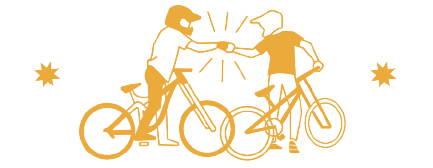How to Ride Steep MTB Features | Mountain Bike Stability Tips from Ben Lomond Trails
This article talks about the movement needed when riding steeper features. For this instructional, we made use of a rock roll to help you train these movements for better control and stability when approaching steeps.
The goal is to develop dynamism in your movements on the bike while using correct judgement and tools to adapt to changing terrain and traction. When you’ve mastered these skills, you’ll feel stable and centred in your full range of movement and able to adapt to changing gradients with precision and control.
To best make use of the article, find a similar feature that you’re comfortable riding, ideally with a flat approach that then becomes steeper before flattening out on the exit. The feature we’ll use starts off relatively flat and then curves into a steeper gradient and then again flattens out on the exit.
Position
Think of this as a gear stick in a manual car—we move it from a neutral position to change gears. Similarly, body position on the bike isn’t fixed and moves up and down depending on changes in terrain. For this feature, we’re going to move from a tall, powerful position to a low, manoeuvrable position and then back to the tall position.
Approaching the feature
Approaching the steep section in a Tall and & Strong position
Keep your braking consistent throughout the feature to maintain a speed you’re comfortable with. The positions now come in so we can adapt to the change in gradient, staying centred and in control. First is the tall, strong position we’ll call “Default”.
Default position
Tall and strong.
Legs are relatively straight with all your weight through the feet.
A slight forward bow at the hips so your chin stays over the stem.
Little to no pressure through the arms.
On the feature
Getting lower and closer to the bike as the Gradient gets steeper.
As soon as the gradient is about to get steeper, absorb the change by moving into the lower, more manoeuvrable position.
How you move closer to the bike makes all the difference. An active hinge in the hips is required. Imagine a sponge ball is placed on your hip flexor and your uppermost part of your thigh and lower most part of your torso are squeezing the ball.
You can also do this by placing your fist on the hip flexor when off the bike. As you move lower your thigh and torso should squeeze equally into the fist. Training this movement off the bike makes a mountain of difference.
Stay low until the gradient flattens out again to maintain manoeuvrability.
The key indicator: As you move lower and closer to the bike, you should feel that your weight stays on your feet throughout. This essentially translates to moving lower while maintaining centredness on the bike.*
*I understand this may be challenging to learn so feel free to pop in a message. We have incredible tools like the SportSense app that have made remote feedback that much more accessible.
Low position
Low and close to the bike.
Active hinge in hips.
Weight stays on feet.
Stay low until gradient is about to flatten out.
The Exit
The change from steep to flat on the exit is effectively a compression so you’ll need to push through with your arms and legs, returning to the default position.
As the feature flattens out , extend your arms first, then legs using your hip hinge to return back to the taller, stronger Default position.
Here’s a task to help you learn the timing and co-ordination for this technique:
Place or draw a marker at the end of the steep section where the trail flattens out.
Stay low and centred through the steep section and crush the marker with your front wheel by pressing through your arms deliberately as you return to your tall, strong default position.
Why? It forces you to stay low for longer, reinforcing proper timing and stability. This way your drive to the taller and stronger position is perfectly timed.
Return to Default position
Push through your arms and legs as gradient flattens.
Extend arms first, then legs using hip hinge.
Push into compression.
Returning back to Tall and Strong as the gradient flattens out.
These coaching techniques were demonstrated at Ben Lomond Trails, one of Queenstown's most iconic riding spots. The terrain is perfect for MTB riders to develop body awareness and terrain reading skills.
🙋♂️ Frequently Asked Questions (FAQ)
How do I keep control on steep MTB trails?
Stay low and centered over the bike, especially during steep transitions. Don’t lean back too far — instead, focus on maneuverability and traction.
What is the best body position for steep descents?
Start tall, drop low as the trail steepens, and return to tall and strong when it flattens. This allows for the most responsive and balanced riding posture.
How can I practice MTB timing for steep sections?
Use the “cone crush” drill — place a cone at the end of a steep section and aim to crush it by returning tall at the right moment.
🚵 Ready to Ride Steep with Confidence?
Want personalized coaching in Queenstown? Join a private lesson or group skills clinic with our certified instructors. Whether you're riding Ben Lomond, Coronet Peak, or Cardrona, we’ll help you ride smoother, safer, and stronger.
👉 Book a lesson now
📧 Have questions? Contact us at management@treadmark.co.nz




